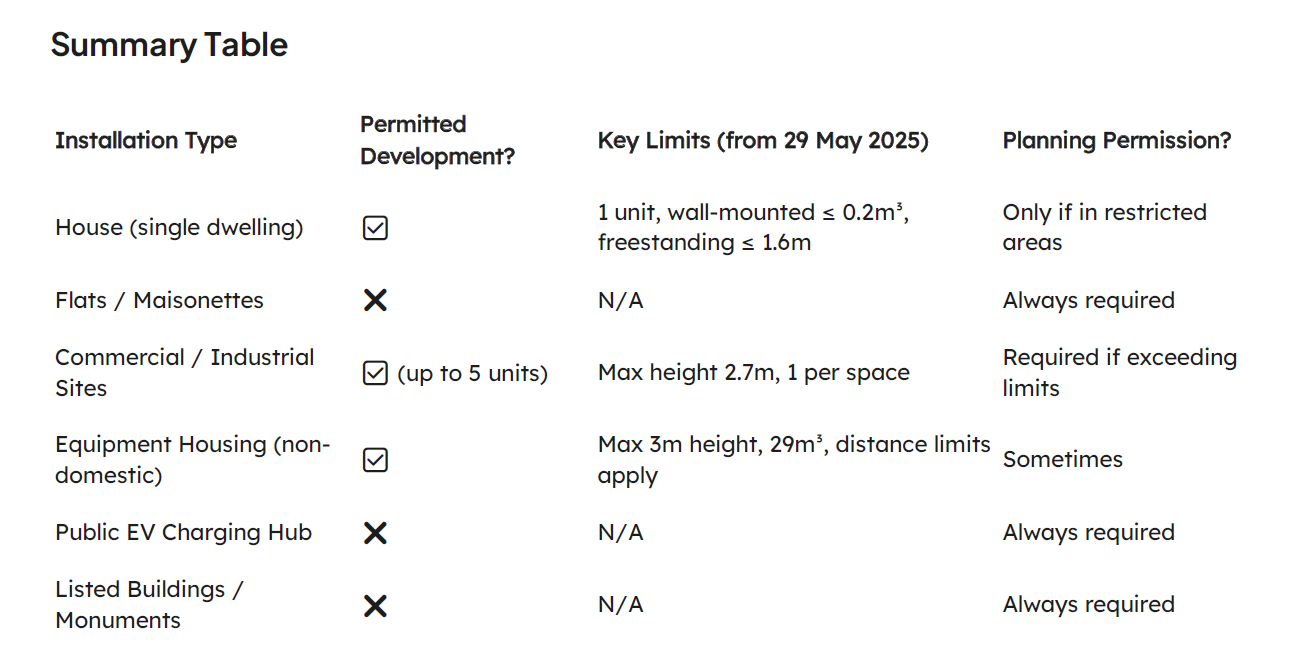Planning and Permitted Development for EV Chargers (England) – Latest legislation

Share
As electric vehicle (EV) adoption grows, demand for domestic and commercial charging infrastructure is accelerating. In response, the UK Government has updated planning regulations to streamline the installation of EV chargers. This briefing outlines the current permitted development rights and planning requirements for EV charging infrastructure in England as of 29 May 2025, following changes to the General Permitted Development Order (GPDO).
Residential Installations
For most single dwellings, installing an EV charger remains straightforward and does not require planning permission, as long as:
- The charger is within the boundary of the property.
- Only one charger is installed per parking space.
- Wall-mounted units are no larger than 0.2 cubic metres.
- Freestanding units are no taller than 1.6 metres.
- New from May 2025: Wall-mounted chargers are now permitted to face a highway.
However, planning permission is still required if the property is a flat, maisonette, listed building, or located in a conservation area, National Park, AONB, or World Heritage Site where Article 4 Directions may apply.
Commercial and Industrial Premises
Businesses can benefit from increased flexibility, with permitted development rights now allowing:
- Up to five wall-mounted or freestanding chargers per site.
- Units up to 2.7 metres tall (previously 2.3m), placed within the site boundary and not within 2 metres of a highway (unless wall-mounted).
Also new from May 2025: Equipment cabinets to support EV infrastructure are permitted under PD rights, provided they:
- Are no taller than 3 metres and under 29 cubic metres in volume.
- Are not placed within 5 metres of a highway or 10 metres of a residential building.
- Are not installed on listed buildings or scheduled monuments.
Beyond these limits or in designated areas, planning permission will still be required.
Public EV Charging Hubs
Standalone EV charging forecourts, rapid hubs, or large-scale public charging sites require full planning permission due to their complexity and impact. These often include:
- A material change of land use
- Multiple chargers, canopies, lighting, and battery storage
- Considerations around highways, noise, light pollution, and biodiversity
Building Regulations – Don’t Overlook Compliance
Regardless of planning requirements, all EV charger installations must meet current Building Regulations:
- Part P – Electrical safety for all installations
- Part S – EV infrastructure for new residential and commercial developments or renovations affecting parking
All work must be carried out by a qualified, competent installer.

Further Information
For additional technical details or to explore how these changes may apply to your site, please get in touch with the C+A Design team. We're here to help guide your EV infrastructure projects from concept through to installation with expert planning and design support.


